brakes FORD EXPEDITION 1997 1.G Owners Manual
[x] Cancel search | Manufacturer: FORD, Model Year: 1997, Model line: EXPEDITION, Model: FORD EXPEDITION 1997 1.GPages: 224, PDF Size: 2.2 MB
Page 3 of 224
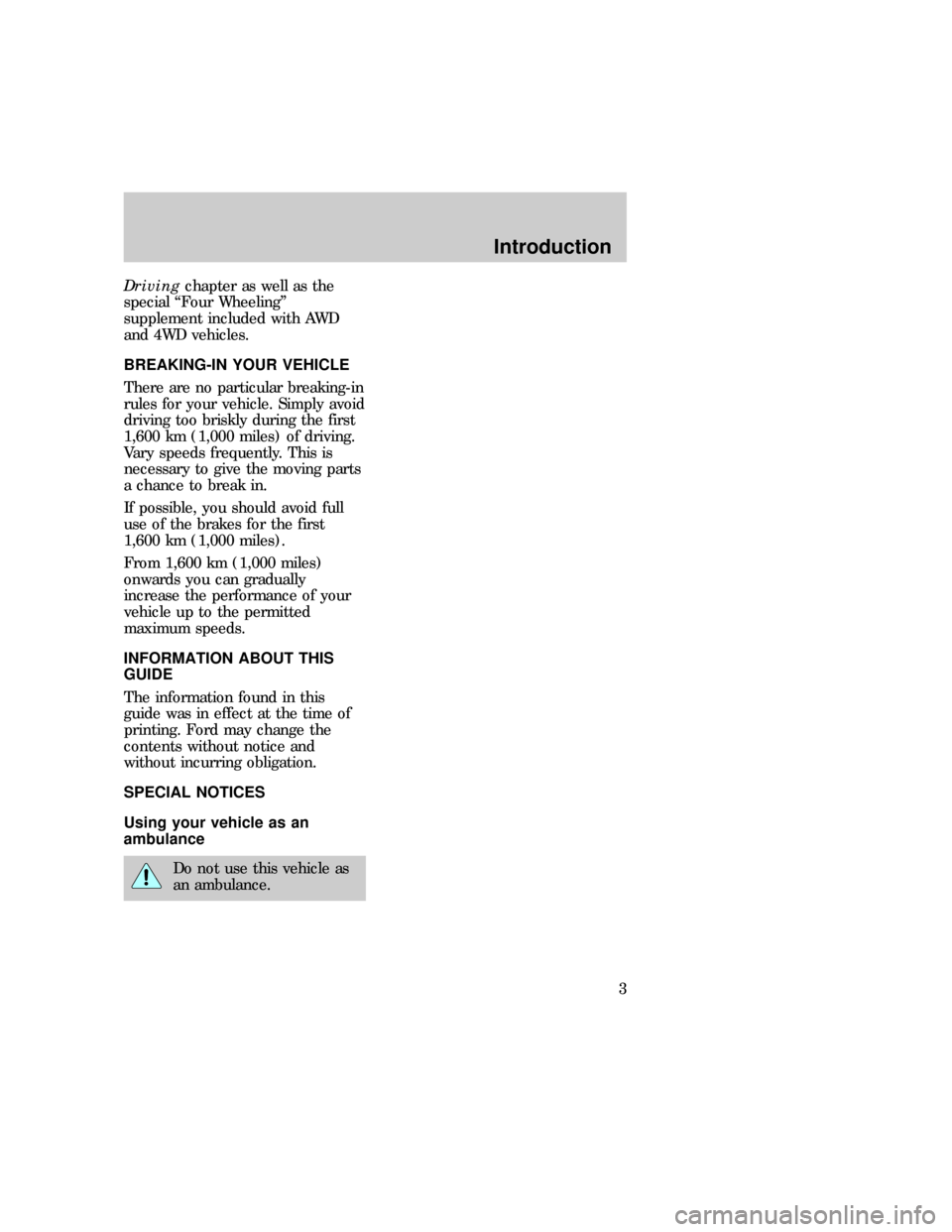
Drivingchapter as well as the
special ªFour Wheelingº
supplement included with AWD
and 4WD vehicles.
BREAKING-IN YOUR VEHICLE
There are no particular breaking-in
rules for your vehicle. Simply avoid
driving too briskly during the first
1,600 km (1,000 miles) of driving.
Vary speeds frequently. This is
necessary to give the moving parts
a chance to break in.
If possible, you should avoid full
use of the brakes for the first
1,600 km (1,000 miles).
From 1,600 km (1,000 miles)
onwards you can gradually
increase the performance of your
vehicle up to the permitted
maximum speeds.
INFORMATION ABOUT THIS
GUIDE
The information found in this
guide was in effect at the time of
printing. Ford may change the
contents without notice and
without incurring obligation.
SPECIAL NOTICES
Using your vehicle as an
ambulance
Do not use this vehicle as
an ambulance.
com_breaking_vehicle.01
com_info_guide.01
exd_special_notices_title
exd_special_ambulance
exd_special_plow
Introduction
3
Page 81 of 224
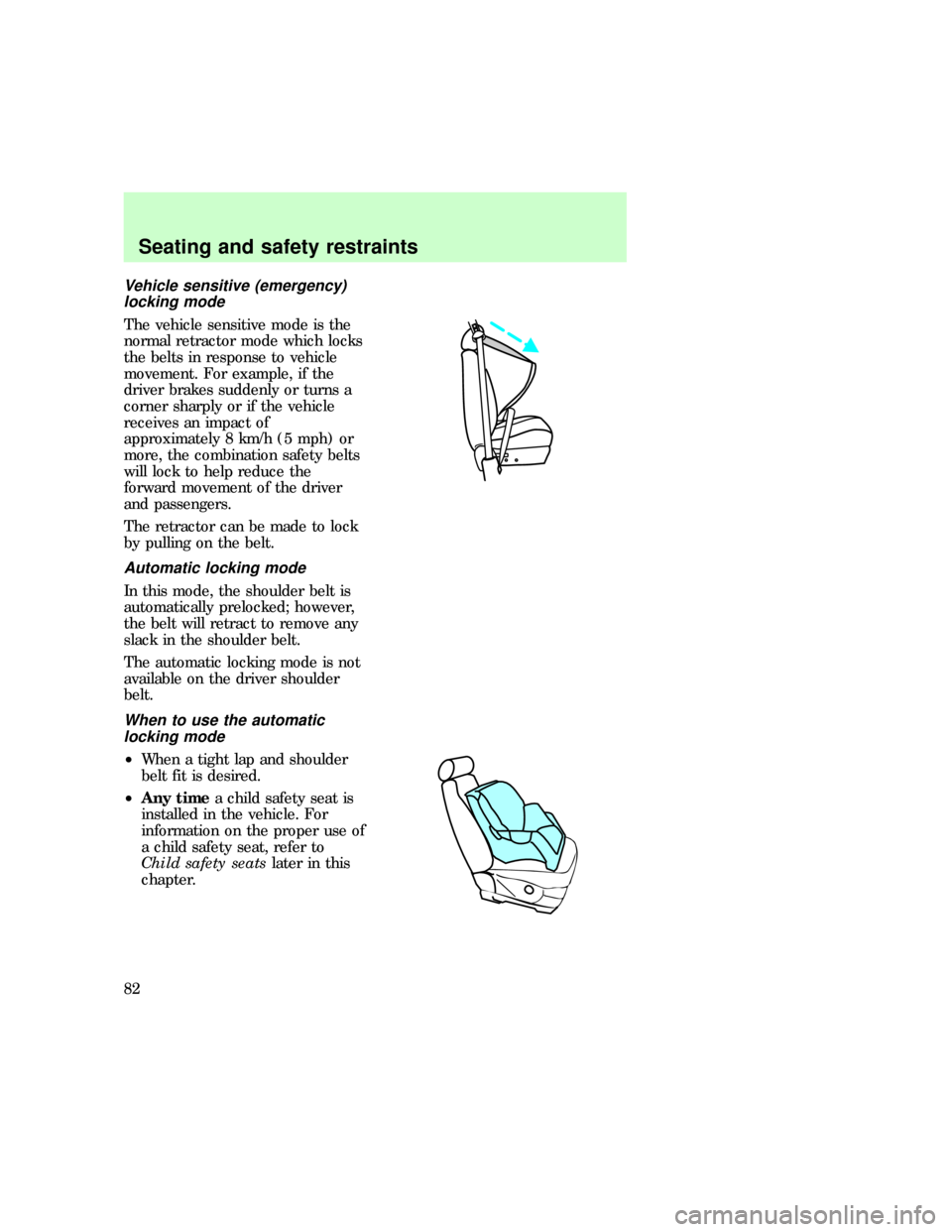
Vehicle sensitive (emergency)
locking mode
The vehicle sensitive mode is the
normal retractor mode which locks
the belts in response to vehicle
movement. For example, if the
driver brakes suddenly or turns a
corner sharply or if the vehicle
receives an impact of
approximately 8 km/h (5 mph) or
more, the combination safety belts
will lock to help reduce the
forward movement of the driver
and passengers.
The retractor can be made to lock
by pulling on the belt.
Automatic locking mode
In this mode, the shoulder belt is
automatically prelocked; however,
the belt will retract to remove any
slack in the shoulder belt.
The automatic locking mode is not
available on the driver shoulder
belt.
When to use the automatic
locking mode
²When a tight lap and shoulder
belt fit is desired.
²Any timea child safety seat is
installed in the vehicle. For
information on the proper use of
a child safety seat, refer to
Child safety seatslater in this
chapter.
exd_automatic_locking_mode
exd_when_to_use_almode
exd_using_auto_locking_mode
Seating and safety restraints
82
Page 106 of 224
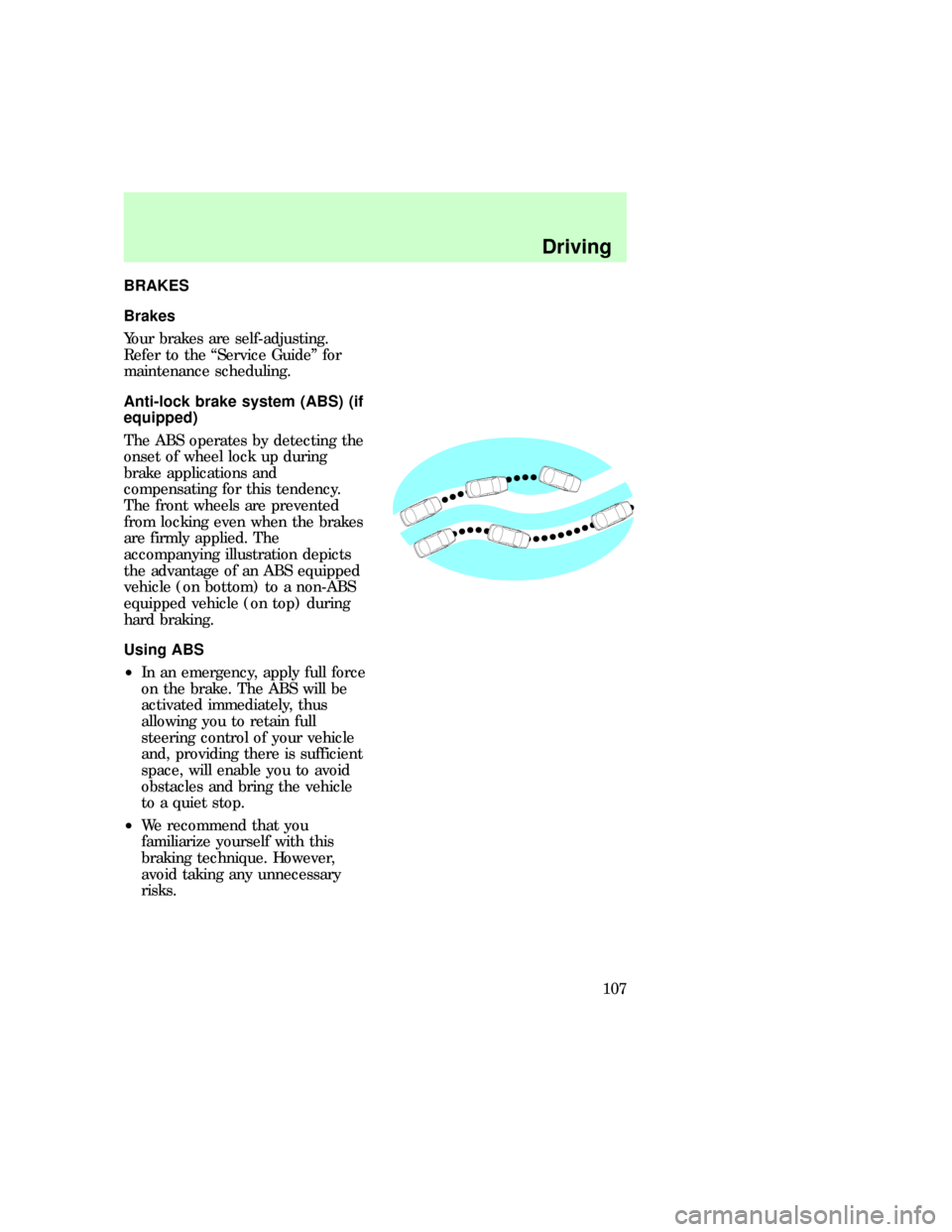
BRAKES
Brakes
Your brakes are self-adjusting.
Refer to the ªService Guideº for
maintenance scheduling.
Anti-lock brake system (ABS) (if
equipped)
The ABS operates by detecting the
onset of wheel lock up during
brake applications and
compensating for this tendency.
The front wheels are prevented
from locking even when the brakes
are firmly applied. The
accompanying illustration depicts
the advantage of an ABS equipped
vehicle (on bottom) to a non-ABS
equipped vehicle (on top) during
hard braking.
Using ABS
²In an emergency, apply full force
on the brake. The ABS will be
activated immediately, thus
allowing you to retain full
steering control of your vehicle
and, providing there is sufficient
space, will enable you to avoid
obstacles and bring the vehicle
to a quiet stop.
²We recommend that you
familiarize yourself with this
braking technique. However,
avoid taking any unnecessary
risks.com_brakes.01
com_abs.01
com_using_abs.01
exd_braking_abs_sys
Driving
107
Page 107 of 224

Braking with ABS
On vehicles with ABS, the wheels
will not lock and slide when you
press down hard on the brake
pedal. The ABS automatically
releases and reapplies the front
and rear brakes independently
whenever the wheels start to lock.
When this happens, you will feel
the brake pedal pulse. This pulse
may be unfamiliar feeling, but it is
a normal indication that the ABS is
working as designed.
Do not ªpumpº the brake pedal of
vehicles with ABS.
exd_parking_brake
Driving
108
Page 126 of 224
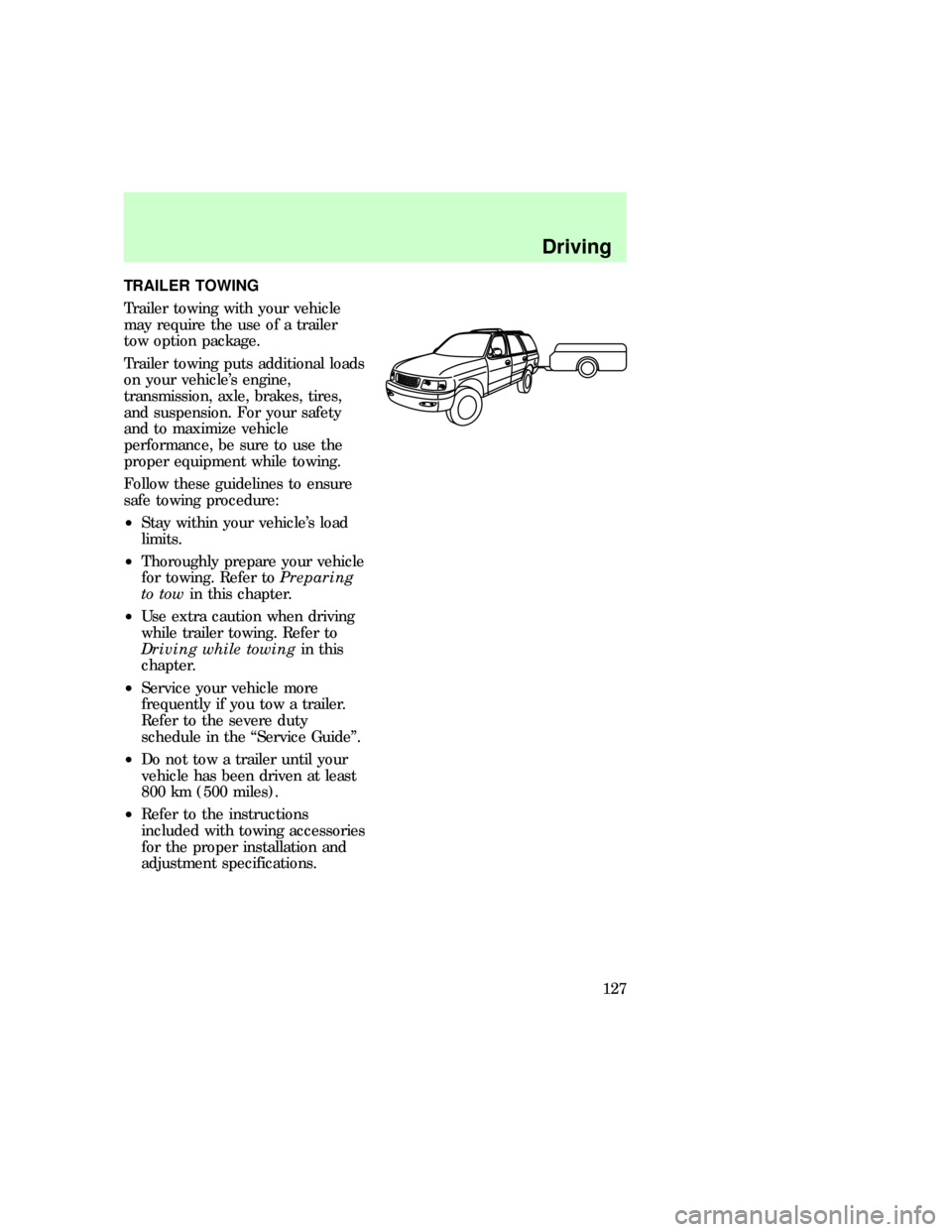
TRAILER TOWING
Trailer towing with your vehicle
may require the use of a trailer
tow option package.
Trailer towing puts additional loads
on your vehicle's engine,
transmission, axle, brakes, tires,
and suspension. For your safety
and to maximize vehicle
performance, be sure to use the
proper equipment while towing.
Follow these guidelines to ensure
safe towing procedure:
²Stay within your vehicle's load
limits.
²Thoroughly prepare your vehicle
for towing. Refer toPreparing
to towin this chapter.
²Use extra caution when driving
while trailer towing. Refer to
Driving while towingin this
chapter.
²Service your vehicle more
frequently if you tow a trailer.
Refer to the severe duty
schedule in the ªService Guideº.
²Do not tow a trailer until your
vehicle has been driven at least
800 km (500 miles).
²Refer to the instructions
included with towing accessories
for the proper installation and
adjustment specifications.
Driving
127
Page 129 of 224
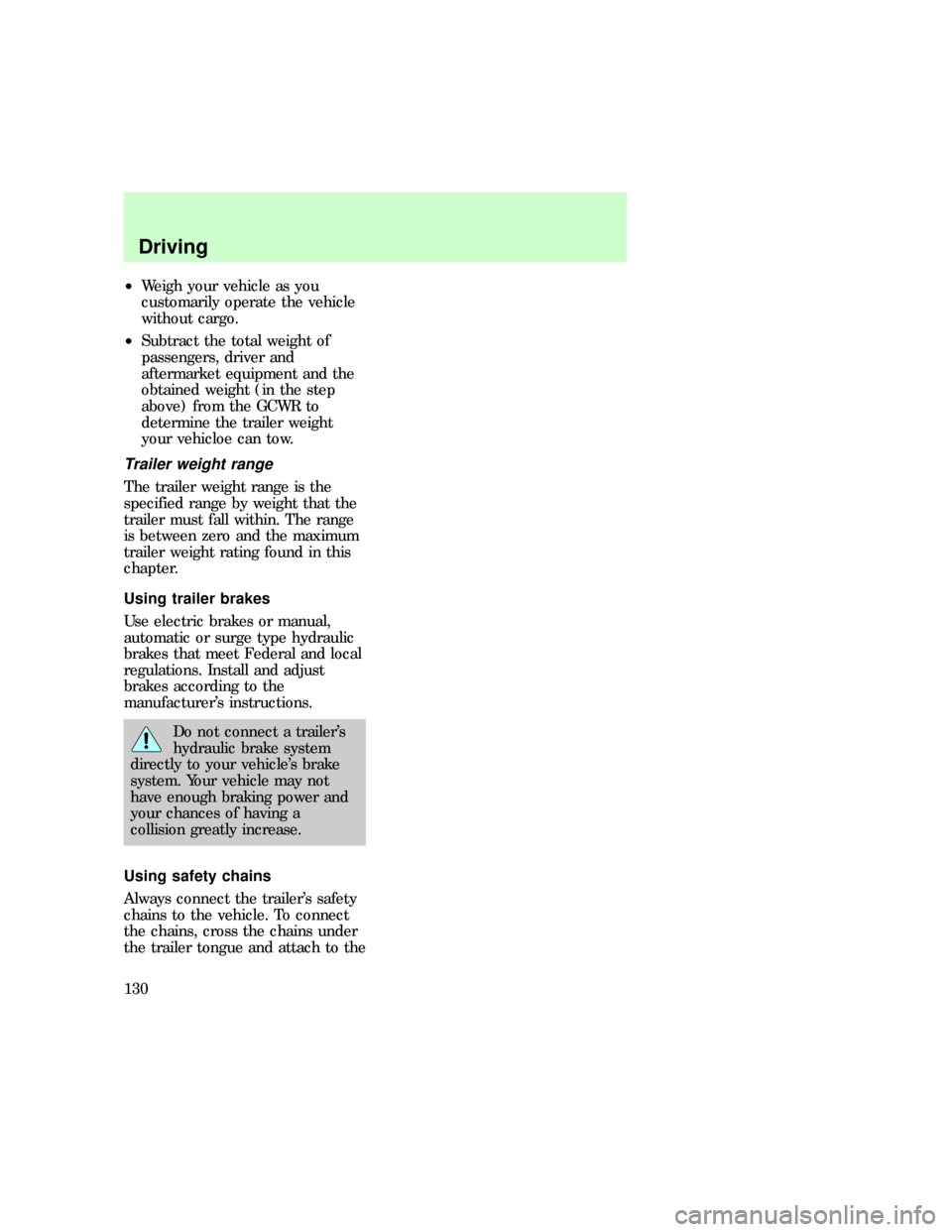
²Weigh your vehicle as you
customarily operate the vehicle
without cargo.
²Subtract the total weight of
passengers, driver and
aftermarket equipment and the
obtained weight (in the step
above) from the GCWR to
determine the trailer weight
your vehicloe can tow.
Trailer weight range
The trailer weight range is the
specified range by weight that the
trailer must fall within. The range
is between zero and the maximum
trailer weight rating found in this
chapter.
Using trailer brakes
Use electric brakes or manual,
automatic or surge type hydraulic
brakes that meet Federal and local
regulations. Install and adjust
brakes according to the
manufacturer's instructions.
Do not connect a trailer's
hydraulic brake system
directly to your vehicle's brake
system. Your vehicle may not
have enough braking power and
your chances of having a
collision greatly increase.
Using safety chains
Always connect the trailer's safety
chains to the vehicle. To connect
the chains, cross the chains under
the trailer tongue and attach to the
exd_weight_range
exd_brakes_trailer
exd_safety_chains
Driving
130
Page 162 of 224
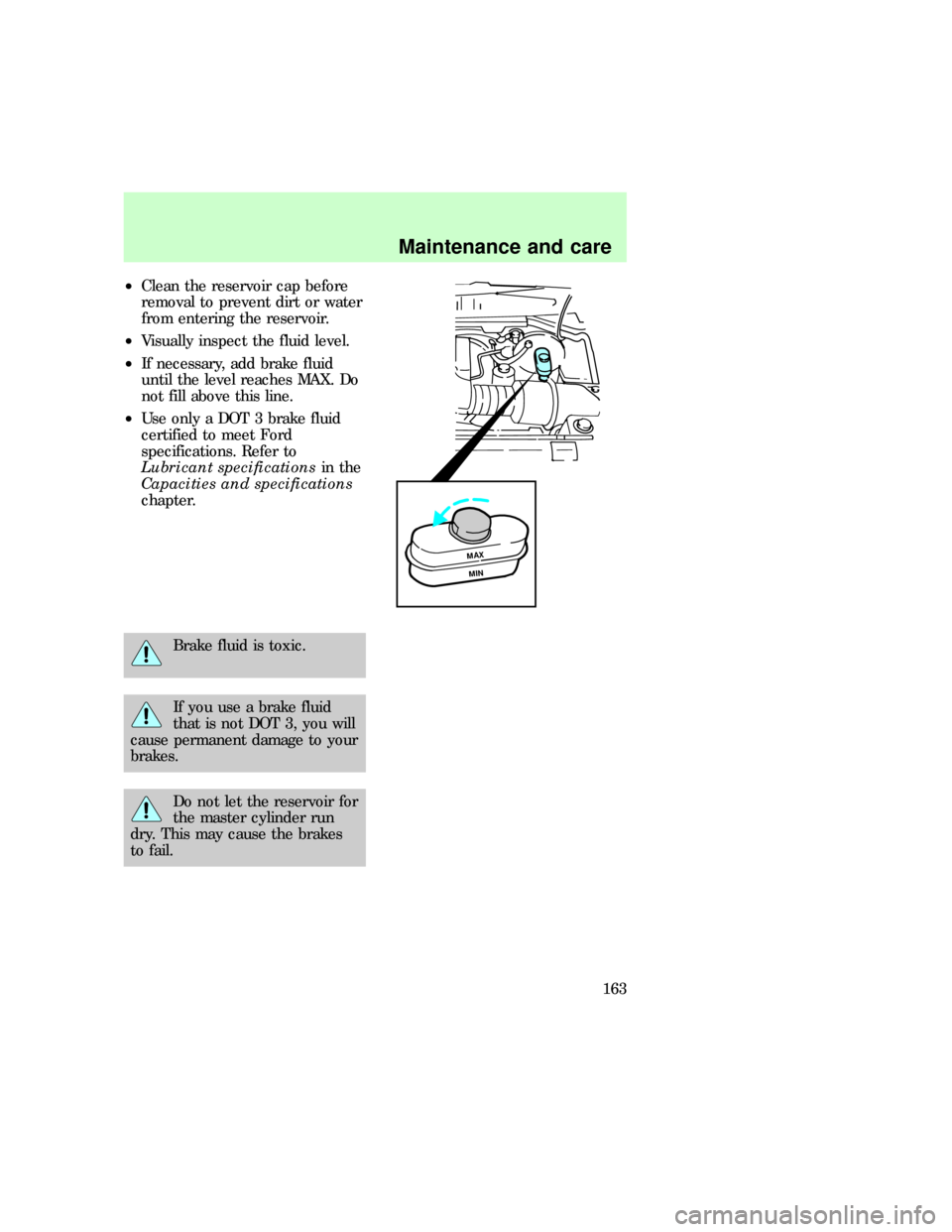
²Clean the reservoir cap before
removal to prevent dirt or water
from entering the reservoir.
²Visually inspect the fluid level.
²If necessary, add brake fluid
until the level reaches MAX. Do
not fill above this line.
²Use only a DOT 3 brake fluid
certified to meet Ford
specifications. Refer to
Lubricant specificationsin the
Capacities and specifications
chapter.
Brake fluid is toxic.
If you use a brake fluid
that is not DOT 3, you will
cause permanent damage to your
brakes.
Do not let the reservoir for
the master cylinder run
dry. This may cause the brakes
to fail.
MAX
MIN
exd_washer-fluid
Maintenance and care
163
Page 206 of 224

such as antennas, before entering
a car wash.
²After washing, apply the brakes
several times to dry them.
Waxing your vehicle
The best way to determine when
the paintwork needs waxing is by
noting when water stops beading
on the surface. This could be every
three or four months, depending
on operating conditions.
Use only carnauba or
synthetic-based waxes. Remove
any bugs and tar before waxing
vehicle. Use cleaning fluid or
alcohol with a clean cloth to
remove. Use tar remover to
remove any tar spots.
Repairing paint chips
Minor scratches or paint damage
from road debris may be repaired
with touch-up paint, paint repair
foil or aerosol paint spray from the
Ford accessory line. Observe the
application instructions on the
products.
Remove particles such as bird
droppings, tree sap, insect
remains, tar spots, road salt and
industrial fallout immediately.
com_waxing_vehicle.01
com_repairing_chips
com_wheels_cleaning.01
Maintenance and care
207
Page 221 of 224

Air bag supplemental restraint
system ..........................................87
and child safety seats ..............88
description ................................87
disposal ......................................91
indicator light ...........................90
passenger air bag .....................89
Air cleaner filter .......................179
Air conditioning
auxiliary heater and air
conditioner ................................37
Air suspension ...........................111
Anti-theft system ........................67
Battery .......................................176
jumping a disabled battery ....151
Brakes ........................................107
adjustment ..............................107
anti-lock ...................................107
fluid, checking and adding ....162
Brake-shift interlock .................117
Break-in period .............................3
Bulbs, replacing .................198,205
headlamps ...............................199
rear lamps ...............................204
specifications ..........................205
Capacities for refilling fluids ...213,
215
Changing a tire .........................147
Cleaning your vehicle ...............206
engine compartment ..............208
fabric ........................................211
instrument panel ....................211
plastic parts ............................209
tail lamps .................................210
washing ....................................206
waxing .....................................207
wheels ......................................208
Climate control system .........27,28
air conditioning ...............32,33,34
defrosting ..................................65
heating .......................................33Compass, electronic
calibration .................................52
set zone adjustment .................52
Console, description ...................63
Controls .......................................64
Defrost
windshield .................................34
Emission control system ..........194
Engine .................................158,218
Engine block heater .................104
Engine coolant ..........................165
checking hoses .......................168
disposal ....................................167
refill capacities ........................167
Engine oil
changing oil and oil filter .......162
specifications ..........................159
Entry system
illumination ...............................54
Exhaust fumes ..........................106
Fail safe cooling ........................169
Floor mats ..............................65,66
Foglamps ..............................20,203
Four-Wheel Drive vehicles
control trac .............................119
special driving instructions ...120,
121
Fuel
calculating fuel economy .......193
improving fuel economy ........133
octane rating ...........................191
quality ......................................191
safety information relating to
automotive fuels .....................189
Fuel pump shut-off switch .......134
Gauges, Electronic ......................14
GVWR (Gross Vehicle Weight
Rating) .......................................123
Hazard flashers .........................134
Hitch ..........................................131
Identification Number, Vehicle
(VIN) ..........................................219
Index
222
Page 222 of 224

Idle
relearning ................................178
Ignition .........................................68
Instrument panel ........................20
Jack ..............................................66
Jump-starting your vehicle 151,152
attaching cables ......................152
disconnecting cables ..............153
Lamps
interior lamps ...........................54
parking lamps .........................201
Lights, warning and indicator
anti-lock brakes (ABS) ............12
brake ..........................................10
charging system ..........................9
high beam .................................12
safety belt ............................10,86
Message center ...........................17
english/metric button ...............18
low fuel level ........................18,19
Motorcraft parts ........................213
Odometer .....................................17
Overdrive .....................................48
Overdrive lockout button ...........11
Overhead console
compass/temperature display ..50
Power features
door locks ..................................60
windows ...............................58,59
Power steering
fluid, checking and adding ....170
Rear console ................................63
Rear window
wiper ..........................................46
Relays ........................................135
Remote entry system
locking/unlocking doors ...........69
panic alarm ...............................69
replacement/additional
transmitters ...............................70
replacing the batteries .............70
Reporting safety defects ..........221Safety restraints
extension assembly ..................85
for children ...............................91
lap and shoulder belts ........82,83
proper use ............................80,81
Safety seats for children ............94
attaching with tether straps ....99
automatic locking mode
(retractor) ............................95,98
Seats ............................................72
bench (60-40 split) .............72,73
lumbar support .........................73
power seat recliner/lumbar ......74
rear flip fold seat ......................75
rear seat access ........................74
third row seat .................76,77,79
Servicing your vehicle ..............155
precautions when servicing ...155
Special notice
utility-type vehicles ....................2
Speed control ..............................41
accelerating ...............................42
resetting ....................................43
resuming a set speed ...............43
turning off .................................41
Speedometer ...............................14
Starting your vehicle ................100
preparing to start your
vehicle .....................................101
starting a warm engine ..........103
Steering, power .........................109
Steering wheel ............................40
Tachometer
mechanical cluster ...................15
Temperature control (see
Climate control) .....................28,29
Tires
changing ..................................144
inspection and maintenance ..182
tire grades ...............................182
treadwear ................................182
Traction-lok rear axle ...............111
Index
223